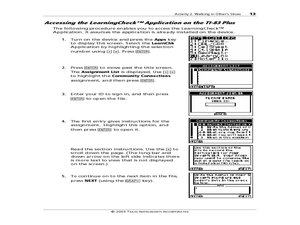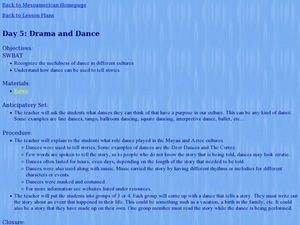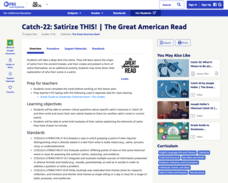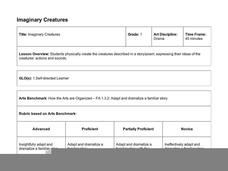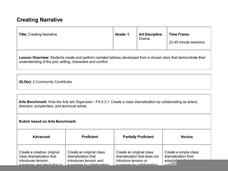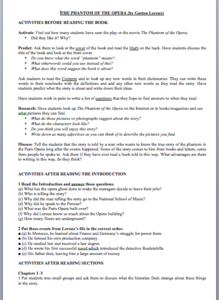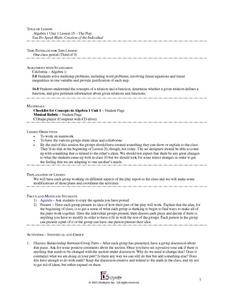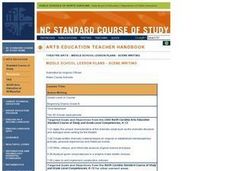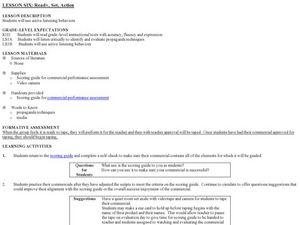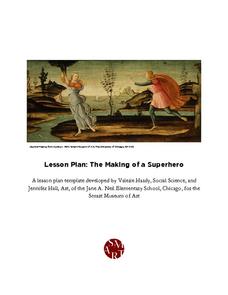Curated OER
Using Drama to Examine Communities: Walking in Others' Shoes
Encourage your readers to make connections between texts with this resource. After compiling notes for each text read (you choose the texts), groups craft skits in which major characters from each text meet. There is a rubric for the...
Curated OER
Drama and Dance
Students create a dance that tells a story then they use the dance for inspiration and write their own. In this drama and dance instructional activity, students discover how the May and Aztec would dance to covey a concept or story....
Judicial Branch of California
Protecting our Freedoms: The Bill of Rights
Take to the stage! Integrate both drama and civic skills by asking pupils to create and perform skills that demonstrate the importance of the amendments in the Bill of Rights. After reviewing the Preamble to the Constitution, learners...
Curated OER
Characters in Live Performance
Your intermediate or advanced thespians choose dramatic scenes to perform in duos, small groups, or solo to demonstrate vocal and physical characterization. Use class time to prepare and rehearse. Detailed rubrics work for peer assessment.
Hawaiʻi State Department of Education
When We Are A Story
Drama and story elements go hand-in-hand. Have the class dive into a dramatic play to show character intention, conflict resolution, main events, and the dialogue in a Hawaiian folk tale. They read the story, then group-up to...
PBS
Catch-22: Satirize This!
Some assignments are great, some can become great, and some have greatness thrust upon them. This one is great. After completing Joseph Heller's classic satire, Catch-22, groups craft and present their own political satire.
Hawaiʻi State Department of Education
Imaginary Creatures
Drama and movement are wonderful ways to cover story elements such as setting, character, and descriptive writing. Little ones listen to a poem about imaginary creatures. As they listen, they shape their bodies into what they think the...
Curated OER
Making Cents of Independence
Have your class explore the history of Texas using this comprehensive lesson! They read about Texas' march toward statehood, the Alamo, and more. There is a series of worksheets, graphic organizers, and a rubric which make this activity...
Curated OER
Identifying Text Features of a Self-Written Fable
Make learning the parts of a book fun by having pupils construct their own glossary entries, table of contents, and title page. Beginning with a review of text features and a hunt for examples, kids use previously written fables to...
Curated OER
The Great Gatsby Historical Background Using Multi-Genre Research Project
Before beginning F. Scott Fitzgerald's The Great Gatsby, create a historical context of the Roaring 20s with this lesson. Set up a gallery walk with the provided PowerPoint, which features 10 topics related to the 1920s. Then begin...
Hawaiʻi State Department of Education
Finding the Main Idea
You can mix almost any subject with an arts curriculum. Find out how to use drama to find the main idea of a literary text. You'll read a story, and then learners will make tableaus showing what happened, or what they think will happen...
Hawaiʻi State Department of Education
Creating Narrative
Plot, setting, characters, and conflict are common to both drama and narrative stories. Kids create narrated tableaus that show their understanding of the plot, setting, and conflict of a story they've recently read. The lesson plan...
Hawaiʻi State Department of Education
Characters from a Box
Character analysis is a skill we use when we read literary works or want to write a good story. Learners will use drama to practice character analysis while focusing on the details that make characters act the way they do. They'll each...
Busy Teacher
The Phantom of the Opera
It's no masquerade! If Gaston Leroux's The Phantom of the Opera is part of your curriculum, check out this three-page packet loaded with suggestions for before, during, and after reading activities.
Star Wars in the Classroom
"Shakespeare and Star Wars": Lesson Plan Day 11
Class members take center stage as groups perform scenes from Ian Doescher's William Shakespeare's Star Wars: Verily, A New Hope. Actors are encouraged to add stage directions to the script, as well as create costumes and props to...
Curated OER
Algebra I: The Play
Students revise their Algebra plays. They collaborate in small groups to work on different aspects of the play and report to the class. They make modifications to their plans and review the Musical Rubric to incorporate the concepts...
Curated OER
Lots of Lessons from Aesop
Aesop’s Fables offer young learners an opportunity to study figurative language. After reviewing theme, simile, alliteration, and metaphor, model for your pupils how to identify examples of these devices in the fable. Class members then...
Friends of Fort McHenry
Sensory “Star Spangled Banner”
Music can help us to access memories and events in a meaningful way, and Francis Scott Key used specific words to convey what he had seen and felt when writing what would become America's national anthem. Help your class connect to...
Curated OER
Scene Writing
Eighth graders create an original scene or short one-act play within specified guidelines. Assessment is based upon the performance of student-created scenes during class time. Rubrics for assessment and connection to state standards...
Curated OER
Ready, Set, Action!
Fifth graders explore sequential dramatization through children's literature. For this drama lesson, 5th graders act out and record scenes using digital and video cameras. Students create a digital poster using pictures from their...
Alabama Department of Archives and History
Alabama's Secession in 1861: Embraced with Joy and Great Confidence. Why?
From December 20, 1860 to June 8, 1861, eleven states seceded from the Union. Alabama seceded on January 11, 1861. Why did so many white Alabamians want to secede? Why did they believe the South could win the war? These are the essential...
Smart Museum of Art
The Making of a Superhero
Thor, Loki, Iron Man, and Captain America. As part of their study of Greek and Roman gods and heroes, middle schoolers compare the characters in The Avengers to Greek counterparts. Individuals then create their own superhero,...
Roald Dahl
Matilda - The Ghost
How do you think the parrot in "The Ghost" chapter of Matilda feels in the chimney? Put a class member in the hot seat and have the class ask questions relating to how they might have felt if they were the parrot in the chimney....
Roald Dahl
Matilda - Throwing the Hammer
Full truth, or an exaggeration? How can you tell when a storyteller is exaggerating a story? Readers analyze a story told by Hortensia, and identify the exaggerative language she uses. Then, learners write their own narrative story using...
Other popular searches
- Free Drama Rubrics
- Elementary Drama Rubrics
- Acting Drama Rubrics
- Drama Rubrics Grade 2
- Drama Rubrics Stage Crew
